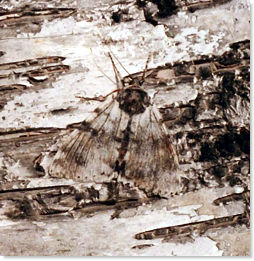
The White Underwing Moth
| By Doug Collicutt | (Click links for more images.) |
Many people think that the emergence of moths from their cocoons is a "spring thing". While it is true that many moths, as well as many butterflies and other insects, gear their life cycles to produce the adult stage of their species in spring, their are just as many that do not. The life cycles of nearly all Manitoba animals are interrupted by our ferocious winters, but they don't all deal with winter in the same way. Within the Lepidoptera, the Order of insects that includes butterflies, moths and skippers, there are some species that spend winter as winged adults, some as pupae, some as caterpillars, and some as eggs. Any stage of an insect's life can be made freeze-resistant! (See: Frozen Alive, an article in our Winter Issue). For as many reasons as there are different species, moths have geared their life cycles to fit into our changing seasons, each in its own unique way. The result is that from May to October there will be winged adults of one kind of moth or another flying around at night. And from late August until well into September, is the time to find one of my favorite moths, the white underwing (Catocala relicta).
White underwing moths signal the end of summer just as surely as the first changing leaves or the skeins of geese overhead. It is a common moth in Manitoba, found as often in urban areas as in the countryside. On warm September nights, it's common to see these large moths flying around street lights or bright billboards. During daylight they are hard to find, for they rest, motionless, on the trunks of trees or on the sides of buildings. In their natural surroundings they are particularly difficult to see during the day, as they are wonderfully camouflaged.
 A White Underwing on a Birch tree is very hard to see.
A White Underwing on a Birch tree is very hard to see.I've been fortunate enough to get hold of some white underwings using my cottage as a "moth trap". I place a small fluorescent light bulb on the outside of my cottage, and leave it on all night. In the morning I check the walls looking for moths that have come to the light, then have become too disoriented and tired to fly away. On the flat, smooth sides of the cottage, even the best camouflaged moth sticks out like a sore thumb. Unfortunately, this also makes them easy pickin's for birds and squirrels. There is many a morning I have gotten up a bit late to find only a pile of moth wings on the steps, with a fat phoebe sitting on my clothes line and a plump chipmunk sunning itself in the sandbox!
I wasn't able to track down much information about the white underwing moth, not that that surprised me! It does frustrate me, though, but it also excites me. There's still so much to learn, about underwing moths and all the other creatures that make Manitoba their home. We at NatureNorth hope that if any of you, out there in cyberland, have any information to add about White Underwings, you'll drop us a line. Think of it as helping us to fill in some "knowledge pot-holes" on the information highway.
Carry on for the Biology of the White Underwing Moth![]()
| You can help NatureNorth produce more great articles with a secure donation through PayPal. Our Google Adsense ads pay our server costs, but that's about it. To learn more follow this link: Support NatureNorth. Thank-you! | |
Return to: Fall Issue | NatureNorth Front page
